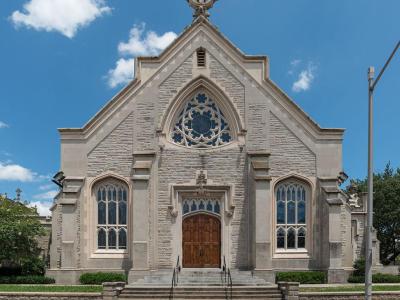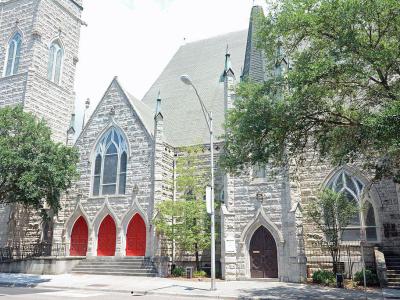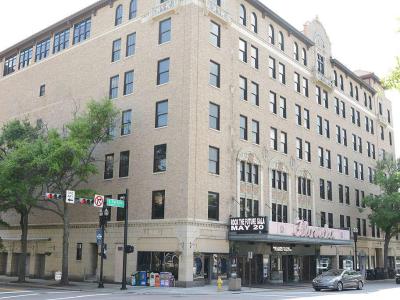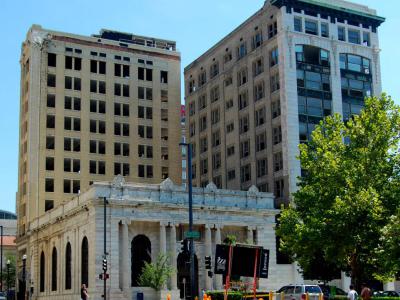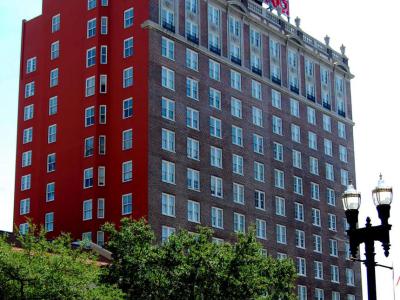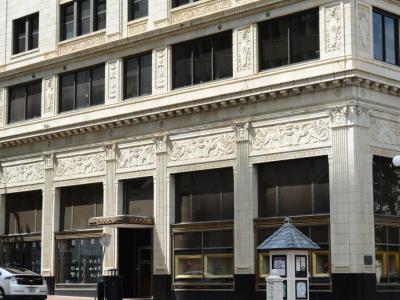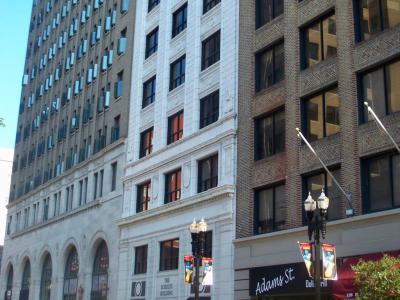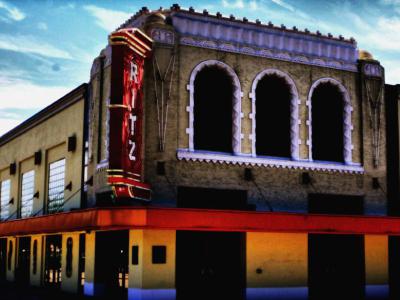
Downtown Historical Buildings Walking Tour (Self Guided), Jacksonville
In the wake of The Great Fire of 1901, the largest-ever inferno in the Southeast, Downtown Jacksonville had be to rebuilt anew. Some of America's most creative and innovative architects of the day, looking to make a name for themselves, like New York City’s Henry John Klutho and Melvin Henry Hubbard, flocked to Jacksonville for the opportunity to rebuild its Downtown area. Guided by their visionary prowess, the city arose from the ashes as a canvas for their ingenuity and skill.
Among the crown jewels of this architectural tableau is the resplendent St James Building, an emblem of opulence and refinement, now home to the City Hall.
The Church of the Immaculate Conception, a sublime sanctuary nestled amidst the bustling urban setting, with its soaring pinnacles and intricately crafted stonework, invites the faithful and the curious alike to contemplate the harmonious interplay of faith and design.
The landmark Laura Street Trio, featuring a set of three historic edifices, namely the Bisbee Building, the Florida Life Building, and the Marble Bank Building, showcases a range of architectural styles such as Chicago School and Beaux-Arts. Together, they gracefully contribute to Jacksonville's historic character.
Punctuating the landscape of Downtown Jacksonville, these and other iconic buildings have stood the test of time. Their stylish century-old structures defy convention and invite all who venture here to witness and marvel at their unparalleled designs – a sight definitely worth a visit!
Among the crown jewels of this architectural tableau is the resplendent St James Building, an emblem of opulence and refinement, now home to the City Hall.
The Church of the Immaculate Conception, a sublime sanctuary nestled amidst the bustling urban setting, with its soaring pinnacles and intricately crafted stonework, invites the faithful and the curious alike to contemplate the harmonious interplay of faith and design.
The landmark Laura Street Trio, featuring a set of three historic edifices, namely the Bisbee Building, the Florida Life Building, and the Marble Bank Building, showcases a range of architectural styles such as Chicago School and Beaux-Arts. Together, they gracefully contribute to Jacksonville's historic character.
Punctuating the landscape of Downtown Jacksonville, these and other iconic buildings have stood the test of time. Their stylish century-old structures defy convention and invite all who venture here to witness and marvel at their unparalleled designs – a sight definitely worth a visit!
How it works: Download the app "GPSmyCity: Walks in 1K+ Cities" from Apple App Store or Google Play Store to your mobile phone or tablet. The app turns your mobile device into a personal tour guide and its built-in GPS navigation functions guide you from one tour stop to next. The app works offline, so no data plan is needed when traveling abroad.
Downtown Historical Buildings Walking Tour Map






Guide Name: Downtown Historical Buildings Walking Tour
Guide Location: USA » Jacksonville (See other walking tours in Jacksonville)
Guide Type: Self-guided Walking Tour (Sightseeing)
# of Attractions: 9
Tour Duration: 2 Hour(s)
Travel Distance: 2.7 Km or 1.7 Miles
Author: sabrina
Sight(s) Featured in This Guide:
Guide Location: USA » Jacksonville (See other walking tours in Jacksonville)
Guide Type: Self-guided Walking Tour (Sightseeing)
# of Attractions: 9
Tour Duration: 2 Hour(s)
Travel Distance: 2.7 Km or 1.7 Miles
Author: sabrina
Sight(s) Featured in This Guide:
- Saint John's Cathedral
- Church of the Immaculate Conception
- First Presbyterian Church
- Florida Theatre
- The Laura Street Trio
- The Carling Hotel
- Greenleaf and Crosby Building
- Atlantic National Bank
- Ritz Theatre and Museum
1) Saint John's Cathedral
The origins of Saint John's Cathedral trace back to a small, all-wooden church that was erected in 1842. However, the winds of change swept through the land during the tumultuous times of the Civil War, and the original structure was consumed by flames, leaving behind only memories and ashes.
From the ashes of loss emerged a vision of grandeur. The construction of the new Saint John's Cathedral became a labor of dedication and devotion, stretching across four years until its completion in 1877. Under the watchful eye of architect Edward Potter, a new beacon of faith took shape—a place where the community could come together, find solace, and share in the beauty of worship.
The Great Fire of 1901, a historic disaster that swept through Jacksonville, dealt a blow to the cathedral's physical form. Despite the destruction, the spirit of resilience prevailed, leading to a reconstruction and redesign that breathed new life into the cathedral's architecture and purpose.
In 1951 Saint John's Church received a new mantle, gaining the prestigious status of the Cathedral of the Episcopal Diocese of Florida. This milestone solidified its role as a spiritual center not just for the faithful within its walls, but for the entire diocese it served.
From the ashes of loss emerged a vision of grandeur. The construction of the new Saint John's Cathedral became a labor of dedication and devotion, stretching across four years until its completion in 1877. Under the watchful eye of architect Edward Potter, a new beacon of faith took shape—a place where the community could come together, find solace, and share in the beauty of worship.
The Great Fire of 1901, a historic disaster that swept through Jacksonville, dealt a blow to the cathedral's physical form. Despite the destruction, the spirit of resilience prevailed, leading to a reconstruction and redesign that breathed new life into the cathedral's architecture and purpose.
In 1951 Saint John's Church received a new mantle, gaining the prestigious status of the Cathedral of the Episcopal Diocese of Florida. This milestone solidified its role as a spiritual center not just for the faithful within its walls, but for the entire diocese it served.
2) Church of the Immaculate Conception
The journey to the creation of the current Immaculate Conception Catholic Church began with a vision—an architectural masterpiece that would stand as a testament to the devotion of the community it would serve. In 1905, architect M. H. Hubbard breathed life into this vision, crafting a design that would blend grace and grandeur into a harmonious whole.
Construction commenced in 1907, and the fruits of labor were unveiled on December 8, 1910. The result was more than a mere church—it was a work of art, an embodiment of Late Gothic Revival architecture that would be hailed as one of the finest examples of its kind in the entire state of Florida.
At first glance, the church's exterior captivates with its stately presence. A cruciform floor plan forms the basis of its design, while pointed arches, tracery-adorned windows, majestic buttresses and pinnacles, soaring spires, and a lofty interior vault all come together to create a symphony of architectural elements that pay homage to a bygone era of artistry.
One of the most striking features of the Church of the Immaculate Conception is its steeple—a remarkable 178.5-foot (54.4 meters) spire that pierces the sky. Crowned by a gold-plated cross, this steeple reached the zenith of Jacksonville's skyline for three years, serving as a beacon of faith and a point of reference for the city's residents.
In 1992, the church's importance was formally recognized as it was listed in the U.S. National Register of Historic Places—a testament to its architectural significance and its role in shaping the city's cultural heritage.
Construction commenced in 1907, and the fruits of labor were unveiled on December 8, 1910. The result was more than a mere church—it was a work of art, an embodiment of Late Gothic Revival architecture that would be hailed as one of the finest examples of its kind in the entire state of Florida.
At first glance, the church's exterior captivates with its stately presence. A cruciform floor plan forms the basis of its design, while pointed arches, tracery-adorned windows, majestic buttresses and pinnacles, soaring spires, and a lofty interior vault all come together to create a symphony of architectural elements that pay homage to a bygone era of artistry.
One of the most striking features of the Church of the Immaculate Conception is its steeple—a remarkable 178.5-foot (54.4 meters) spire that pierces the sky. Crowned by a gold-plated cross, this steeple reached the zenith of Jacksonville's skyline for three years, serving as a beacon of faith and a point of reference for the city's residents.
In 1992, the church's importance was formally recognized as it was listed in the U.S. National Register of Historic Places—a testament to its architectural significance and its role in shaping the city's cultural heritage.
3) First Presbyterian Church
Founded in 1840, the First Presbyterian Church holds the distinction of being the oldest religious body in the city—an institution that has weathered the tests of time and embraced the community with open arms for generations.
In 1844, the journey took a significant step forward with the generosity of retired sea captain O. Conger. Through his assistance, a new sanctuary at Newnan Street was acquired. This new spiritual home stood as a testament to the vision of a community coming together to create a space that would stand as a cornerstone of faith for years to come.
As time flowed forward, the church's evolution continued. In 1847, with additional support from Conger, the foundations of a new structure were laid. However, it was in 1855 that Miss Phoebe Swart's patronage paved the way for the church's remodeling and enlargement.
During the tumultuous times of the American Civil War, the church's walls bore witness to a different kind of struggle. Repurposed as a hospital, it transformed from a place of worship into a sanctuary of a different sort—a space where healing, compassion, and resilience converged.
Today, the First Presbyterian Church stands as a testament to the enduring spirit of community. Its beautiful Gothic architecture serves as a visual anchor, a landmark that pays homage to the past while welcoming the present and future.
In 1844, the journey took a significant step forward with the generosity of retired sea captain O. Conger. Through his assistance, a new sanctuary at Newnan Street was acquired. This new spiritual home stood as a testament to the vision of a community coming together to create a space that would stand as a cornerstone of faith for years to come.
As time flowed forward, the church's evolution continued. In 1847, with additional support from Conger, the foundations of a new structure were laid. However, it was in 1855 that Miss Phoebe Swart's patronage paved the way for the church's remodeling and enlargement.
During the tumultuous times of the American Civil War, the church's walls bore witness to a different kind of struggle. Repurposed as a hospital, it transformed from a place of worship into a sanctuary of a different sort—a space where healing, compassion, and resilience converged.
Today, the First Presbyterian Church stands as a testament to the enduring spirit of community. Its beautiful Gothic architecture serves as a visual anchor, a landmark that pays homage to the past while welcoming the present and future.
4) Florida Theatre
The Florida Theatre is a historic movie theater that holds a significant place in American cinema history. Opening its doors in April 1927, the theater has captivated audiences for nearly a century with its grandeur and architectural beauty. Its historical significance was recognized when it was added to the U.S. National Register of Historic Places on November 4, 1982.
During the 1920s, Florida experienced a Mediterranean Revival architectural boom, and the Florida Theatre stands as one of the four remaining high-style movie palaces from that era in the state. The other three theaters are the Saenger Theatre in Pensacola, the Polk Theatre in Lakeland, and the Tampa Theatre in Tampa. These theaters share a common architectural style characterized by ornate detailing, lavish interiors, and a sense of opulence.
The Florida Theatre exemplifies the Mediterranean Revival style with its stunning facade and intricately designed interiors. The theater's exterior features decorative elements such as ornamental sculptures, intricate carvings, and a prominent marquee that still lights up the streets of Jacksonville. The grand entrance beckons visitors with its elegant arched doors and ornate detailing, transporting them to a bygone era of classic cinema.
Inside, the theater continues to awe guests with its lavish interiors. The ornamental details, including the hand-painted ceilings, intricate moldings, and majestic chandeliers, create an atmosphere of elegance and grandeur. The auditorium itself is designed with a sloping floor, ensuring excellent sightlines for all patrons. With a seating capacity of over 1,900, the Florida Theatre has hosted countless movie premieres, live performances, and cultural events throughout its rich history.
During the 1920s, Florida experienced a Mediterranean Revival architectural boom, and the Florida Theatre stands as one of the four remaining high-style movie palaces from that era in the state. The other three theaters are the Saenger Theatre in Pensacola, the Polk Theatre in Lakeland, and the Tampa Theatre in Tampa. These theaters share a common architectural style characterized by ornate detailing, lavish interiors, and a sense of opulence.
The Florida Theatre exemplifies the Mediterranean Revival style with its stunning facade and intricately designed interiors. The theater's exterior features decorative elements such as ornamental sculptures, intricate carvings, and a prominent marquee that still lights up the streets of Jacksonville. The grand entrance beckons visitors with its elegant arched doors and ornate detailing, transporting them to a bygone era of classic cinema.
Inside, the theater continues to awe guests with its lavish interiors. The ornamental details, including the hand-painted ceilings, intricate moldings, and majestic chandeliers, create an atmosphere of elegance and grandeur. The auditorium itself is designed with a sloping floor, ensuring excellent sightlines for all patrons. With a seating capacity of over 1,900, the Florida Theatre has hosted countless movie premieres, live performances, and cultural events throughout its rich history.
5) The Laura Street Trio
The Laura Street Trio, a triumphant display of architectural mastery and historical significance, graces Jacksonville, Florida with its timeless presence. Еhis ensemble of three stunning structures forms a harmonious symphony of design and history that captures the essence of the city's evolution.
At the heart of the Laura Street Trio are three distinct buildings, each possessing its own character and charm. Anchoring this architectural ensemble are the Florida Life Building and the Bisbee Building, two perpendicular skyscrapers that stand as testaments to innovation and vision. The third element, the Old Florida National Bank, sits framed by its companions, creating a unique visual pattern that is both captivating and harmonious.
While the buildings are currently undergoing significant restoration efforts, their architectural allure remains evident from the outside. The facade of each structure carries with it a story of craftsmanship and artistry, inviting passersby to admire the elegance that time has bestowed upon them.
The oldest among the trio, the Old Florida National Bank, built in 1902, is affectionately known as the Marble Bank due to its marbled exterior. This building stands as a testament to the classical Revival Style, bearing the touch of architect Edward H. Glidden.
The Bisbee Building, constructed between 1908 and 1909, is a shining example of the Prairie Style, brought to life through the artistic vision of renowned architect Henry J. Klutho. This building stands as a pioneering achievement, being the first concrete-reinforced high-rise across the entire Southern United States. Its distinctive design elements and forward-thinking engineering pay homage to Klutho's innovative spirit.
Completing the trio is the Florida Life Building, erected between 1911 and 1912, and again masterfully crafted by Henry J. Klutho. This 11-story monument to architectural grandeur once held the title of Jacksonville's and Florida's tallest building. Its commanding presence and towering stature reflect the aspirations and ambitions of a city on the rise.
At the heart of the Laura Street Trio are three distinct buildings, each possessing its own character and charm. Anchoring this architectural ensemble are the Florida Life Building and the Bisbee Building, two perpendicular skyscrapers that stand as testaments to innovation and vision. The third element, the Old Florida National Bank, sits framed by its companions, creating a unique visual pattern that is both captivating and harmonious.
While the buildings are currently undergoing significant restoration efforts, their architectural allure remains evident from the outside. The facade of each structure carries with it a story of craftsmanship and artistry, inviting passersby to admire the elegance that time has bestowed upon them.
The oldest among the trio, the Old Florida National Bank, built in 1902, is affectionately known as the Marble Bank due to its marbled exterior. This building stands as a testament to the classical Revival Style, bearing the touch of architect Edward H. Glidden.
The Bisbee Building, constructed between 1908 and 1909, is a shining example of the Prairie Style, brought to life through the artistic vision of renowned architect Henry J. Klutho. This building stands as a pioneering achievement, being the first concrete-reinforced high-rise across the entire Southern United States. Its distinctive design elements and forward-thinking engineering pay homage to Klutho's innovative spirit.
Completing the trio is the Florida Life Building, erected between 1911 and 1912, and again masterfully crafted by Henry J. Klutho. This 11-story monument to architectural grandeur once held the title of Jacksonville's and Florida's tallest building. Its commanding presence and towering stature reflect the aspirations and ambitions of a city on the rise.
6) The Carling Hotel
The Carling Hotel, a Jacksonville architectural gem steeped in history and elegance, stands as a testament to the city's past and its enduring resilience. Erected in 1925, this majestic 13-story edifice, originally boasting more than 300 rooms, was brought to life by the creative vision of New York City architects Thompson, Holmes & Converse, who wove the Italian Renaissance Style into its very fabric.
Upon encountering The Carling, one's gaze is drawn to the striking façade that tells a story of architectural finesse and attention to detail. The lower three stories are adorned with Indiana limestone, exuding an air of grandeur and permanence. As the building ascends towards the sky, the upper levels are adorned with terra-cotta trimmings, adding a touch of artistic intricacy that captures the eye and imagination.
The building's unique placement sets it apart, situated in the heart of a block rather than at a corner like traditional structures. This placement, a deviation from convention, adds to the allure of The Carling, reflecting its distinctive character and the visionary approach of its creators.
In 1936, the building underwent a transformation, embracing a new identity as the Hotel Roosevelt for a span of over 25 years. This period saw an addition to the rear of the building, a two-story extension that provided access from Monroe Street, enriching the hotel's functionality and accessibility.
Tragedy struck in 1963 when a devastating fire claimed 22 lives, forcing the closure of the Hotel Roosevelt. The building, once a bustling hub of activity, stood vacant for nearly two decades until it underwent another metamorphosis. Transformed into apartments for retirees, it held the echoes of its past while adapting to new roles.
Recognition of its historical importance came in 1991, when The Carling was added to the U.S. National Register of Historic Places.
Upon encountering The Carling, one's gaze is drawn to the striking façade that tells a story of architectural finesse and attention to detail. The lower three stories are adorned with Indiana limestone, exuding an air of grandeur and permanence. As the building ascends towards the sky, the upper levels are adorned with terra-cotta trimmings, adding a touch of artistic intricacy that captures the eye and imagination.
The building's unique placement sets it apart, situated in the heart of a block rather than at a corner like traditional structures. This placement, a deviation from convention, adds to the allure of The Carling, reflecting its distinctive character and the visionary approach of its creators.
In 1936, the building underwent a transformation, embracing a new identity as the Hotel Roosevelt for a span of over 25 years. This period saw an addition to the rear of the building, a two-story extension that provided access from Monroe Street, enriching the hotel's functionality and accessibility.
Tragedy struck in 1963 when a devastating fire claimed 22 lives, forcing the closure of the Hotel Roosevelt. The building, once a bustling hub of activity, stood vacant for nearly two decades until it underwent another metamorphosis. Transformed into apartments for retirees, it held the echoes of its past while adapting to new roles.
Recognition of its historical importance came in 1991, when The Carling was added to the U.S. National Register of Historic Places.
7) Greenleaf and Crosby Building
The Greenleaf & Crosby Building, a striking piece of Jacksonville's architectural heritage, holds a unique story that resonates through its distinctive design and historical significance. Erected in 1927 to house the prestigious Greenleaf & Crosby Company, a prominent jewelry store deeply rooted in Jacksonville's history, this building stands as a testament to an era of opulence and elegance.
The architects behind this remarkable creation were Marsh and Saxelbye, notable figures of their time renowned for their architectural prowess. Their original plan called for a six-story structure, yet due to unforeseen circumstances, the developer managed to bring to life a twelve-story marvel on one side. A remarkable quirk of fate played its hand, leaving one side unfinished as more funding was sought but never materialized. This unintentional asymmetry conferred a unique and captivating "lopsided" appearance upon the building, setting it apart from the conventional architectural norms of its time.
As the eyes ascend the Greenleaf & Crosby Building, one is greeted by an array of intricate and visually captivating terra-cotta panels. These masterfully crafted adornments depict a menagerie of mythical griffins, regal eagles, ornate urns, and delicate floral motifs. The lower façade of the building boasts a magnificent two-story vaulted entrance, a grandeur that has the power to transport modern-day passersby to a bygone era of sophistication and style. This entrance served as a portal to the opulent world within, inviting patrons into the realm of fine jewelry and luxury that was Greenleaf & Crosby's domain.
Upon departing the building, a notable landmark awaits visitors: the Historic Jacobs Jewelers clock, a majestic timepiece dating back to 1901 and crafted by the esteemed Seth Thomas Clock Company of Connecticut. This 2.2-ton masterpiece, an ambassador of history, has graced this corner since 1930, faithfully ticking away the passage of time and serving as a reminder of the building's enduring legacy.
The architects behind this remarkable creation were Marsh and Saxelbye, notable figures of their time renowned for their architectural prowess. Their original plan called for a six-story structure, yet due to unforeseen circumstances, the developer managed to bring to life a twelve-story marvel on one side. A remarkable quirk of fate played its hand, leaving one side unfinished as more funding was sought but never materialized. This unintentional asymmetry conferred a unique and captivating "lopsided" appearance upon the building, setting it apart from the conventional architectural norms of its time.
As the eyes ascend the Greenleaf & Crosby Building, one is greeted by an array of intricate and visually captivating terra-cotta panels. These masterfully crafted adornments depict a menagerie of mythical griffins, regal eagles, ornate urns, and delicate floral motifs. The lower façade of the building boasts a magnificent two-story vaulted entrance, a grandeur that has the power to transport modern-day passersby to a bygone era of sophistication and style. This entrance served as a portal to the opulent world within, inviting patrons into the realm of fine jewelry and luxury that was Greenleaf & Crosby's domain.
Upon departing the building, a notable landmark awaits visitors: the Historic Jacobs Jewelers clock, a majestic timepiece dating back to 1901 and crafted by the esteemed Seth Thomas Clock Company of Connecticut. This 2.2-ton masterpiece, an ambassador of history, has graced this corner since 1930, faithfully ticking away the passage of time and serving as a reminder of the building's enduring legacy.
8) Atlantic National Bank
Erected in 1909, this iconic structure was originally home to the Atlantic National Bank, a name that resonated throughout the city and beyond. This towering masterpiece, designed by the accomplished New York City architects Mowbray and Uffinger, stands as a testament to architectural brilliance and historical importance.
During its early years, the building reigned as a symbol of architectural and engineering prowess. Rising majestically to a height that dominated the Jacksonville skyline, it stood as the tallest building in both the city and the state of Florida from its completion in 1909 until 1912.
The exterior of the building is an architectural marvel, capturing attention with its impressive façade. The lower two floors are adorned with an elegant white Sylacauga marble covering, exuding a sense of opulence and grandeur. As the gaze travels upwards, the top eight floors are adorned with intricate white terra cotta details, showcasing the architects' attention to aesthetic detail and craftsmanship.
A subtle yet significant element etched into the building's history is the engraved "ANB" above its entrance. This serves as a timeless reminder of its origins as the Atlantic National Bank building, a symbol of the financial institution's prominence and influence in the region.
Today, the building bears the name "Schultz Building," serving as a hub for various offices and businesses. Its enduring presence underscores its adaptability and relevance, even as the years have brought forth significant changes.
One of the most captivating features of the building's history resides beneath its surface: a network of pedestrian tunnels. Constructed at the turn of the last century, these tunnels served as connectors between bank buildings, facilitating ease of movement for patrons. Among the Downtown Jacksonville tunnels of that era, the one beneath the Atlantic National Bank Building stands out as the sole tunnel still in use today. Portions of this remarkable subterranean pathway are accessible to the public, offering a unique glimpse into the city's history and the innovative solutions of yesteryears.
During its early years, the building reigned as a symbol of architectural and engineering prowess. Rising majestically to a height that dominated the Jacksonville skyline, it stood as the tallest building in both the city and the state of Florida from its completion in 1909 until 1912.
The exterior of the building is an architectural marvel, capturing attention with its impressive façade. The lower two floors are adorned with an elegant white Sylacauga marble covering, exuding a sense of opulence and grandeur. As the gaze travels upwards, the top eight floors are adorned with intricate white terra cotta details, showcasing the architects' attention to aesthetic detail and craftsmanship.
A subtle yet significant element etched into the building's history is the engraved "ANB" above its entrance. This serves as a timeless reminder of its origins as the Atlantic National Bank building, a symbol of the financial institution's prominence and influence in the region.
Today, the building bears the name "Schultz Building," serving as a hub for various offices and businesses. Its enduring presence underscores its adaptability and relevance, even as the years have brought forth significant changes.
One of the most captivating features of the building's history resides beneath its surface: a network of pedestrian tunnels. Constructed at the turn of the last century, these tunnels served as connectors between bank buildings, facilitating ease of movement for patrons. Among the Downtown Jacksonville tunnels of that era, the one beneath the Atlantic National Bank Building stands out as the sole tunnel still in use today. Portions of this remarkable subterranean pathway are accessible to the public, offering a unique glimpse into the city's history and the innovative solutions of yesteryears.
9) Ritz Theatre and Museum
The Ritz Theatre and Museum, nestled in Jacksonville's LaVilla neighborhood, serves as a vibrant hub of African-American culture and heritage. With its rich history and diverse offerings, this theater stands as a cherished space that celebrates artistic expression, community, and the legacy of a vibrant neighborhood.
The Ritz Theatre, designed in the Art Deco style by local architect Jefferson Powell, emerged in 1929 on the grounds where the Ritz Theater movie house once stood. This venue, with a seating capacity of 426, has played host to a myriad of music, dance, and theatrical performances, as well as cinematic experiences. The stage has echoed with the rhythms of soulful music, the grace of dancers, and the resonance of stories that encapsulate the African-American experience.
Beyond the stage, the theater's spacious lobby extends a warm welcome to all, serving not only as a gathering place for theatergoers but also as a venue for private events that forge connections and memories.
LaVilla itself holds a storied past, once known as the "Harlem of the South" from 1921 to 1971. The neighborhood pulsated with life and creativity, becoming a focal point for African-American cultural expression and community engagement. But, the entertainment district of LaVilla experienced a decline from the 1970s onwards, with rising crime and dwindling vibrancy. However, the vision of revitalization found a champion in Mayor Ed Austin's River City Renaissance plan, culminating in the grand reopening on September 30, 1999. While the original building saw transformations, a sign and the northwest corner stand as remnants that bridge the past and present.
The Ritz Theatre, designed in the Art Deco style by local architect Jefferson Powell, emerged in 1929 on the grounds where the Ritz Theater movie house once stood. This venue, with a seating capacity of 426, has played host to a myriad of music, dance, and theatrical performances, as well as cinematic experiences. The stage has echoed with the rhythms of soulful music, the grace of dancers, and the resonance of stories that encapsulate the African-American experience.
Beyond the stage, the theater's spacious lobby extends a warm welcome to all, serving not only as a gathering place for theatergoers but also as a venue for private events that forge connections and memories.
LaVilla itself holds a storied past, once known as the "Harlem of the South" from 1921 to 1971. The neighborhood pulsated with life and creativity, becoming a focal point for African-American cultural expression and community engagement. But, the entertainment district of LaVilla experienced a decline from the 1970s onwards, with rising crime and dwindling vibrancy. However, the vision of revitalization found a champion in Mayor Ed Austin's River City Renaissance plan, culminating in the grand reopening on September 30, 1999. While the original building saw transformations, a sign and the northwest corner stand as remnants that bridge the past and present.
Walking Tours in Jacksonville, Florida
Create Your Own Walk in Jacksonville
Creating your own self-guided walk in Jacksonville is easy and fun. Choose the city attractions that you want to see and a walk route map will be created just for you. You can even set your hotel as the start point of the walk.
Jacksonville Introduction Walking Tour
Gracefully adorning the northeastern part of Florida along the banks of the St Johns River and the Atlantic Ocean, Jacksonville is a resplendent gem in the sun-kissed landscape of the Sunshine State.
Founded in 1822, Jacksonville, Florida, boasts a rich history as a major port and a vital military and industrial hub. The name "Jacksonville" was chosen to honor Andrew Jackson, a... view more
Tour Duration: 2 Hour(s)
Travel Distance: 3.1 Km or 1.9 Miles
Founded in 1822, Jacksonville, Florida, boasts a rich history as a major port and a vital military and industrial hub. The name "Jacksonville" was chosen to honor Andrew Jackson, a... view more
Tour Duration: 2 Hour(s)
Travel Distance: 3.1 Km or 1.9 Miles
The Most Popular Cities
/ view all
